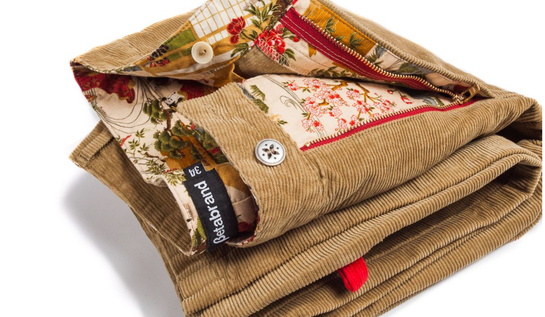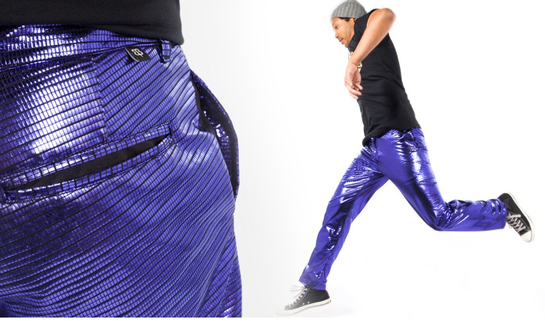How to Build Brand Recall in a Clickless World
Brand awareness is dwindling in organic search. Here's your strategy for building brand equity and recall by leveraging brand awareness. Learn more here.
Read More
When people think about articles of clothing that have left a permanent mark on fashion, most likely imagine a piece of couture from a classic French or Italian designer. Some might picture streetwear giants like Supreme or Comme de Garcon. Some might even make compelling cases for a company like Bonobos, which primed the world for direct-to-consumer (D2C) clothing companies with their easy-wearing chinos, or Indochino, the first mainstream online made-to-measure suit company.
Few people think Cordarounds — corduroy pants with the ribs going horizontally instead of vertically. And yet these humble beginnings mark the growth of one of the hottest fashion brands in Silicon Valley. Since these humble beginnings in 2005, Cordarounds has grown into Betabrand, which has grown into an “if you know, you know; and if you don’t, you will soon” favorite. In 2013, the brand broke out of the Valley with the launch of their most iconic piece — Dress Pant Yoga Pants — but the inevitability of their success was cemented long before then.
In this article:
Crowdsourcing Before Crowdsourcing
What Drives Betabrand?
The Roll-Up
It would be an understatement to say that “crowdsourcing” was in its infancy in 2005. Sure, the idea of using an army of volunteers to help create something wasn’t new — the Oxford English Dictionary was famously crowd-sourced by a team of 800 volunteers in 1884 — but the term “crowdsourcing” as we understand it today wasn’t actually coined until 2006. Crowdfunding was even further away — Kickstarter didn’t launch until 2009.
So it was that in 2005, Chris Lindland found himself with a crazy idea, some bad jokes about horizontal stripes, and no ready-made platform on which to share his discovery with the world. Instead, he began talking with his friends about his plan to make horizontal corduroy pants. His friends had suggestions on how to make them better, and (perhaps surprisingly) the desire to purchase a pair.
Cordarounds was born out of that back-and-forth between Lindland and his friends, who (perhaps even more surprisingly) helped front the money for Lindland to create a prototype, and then begin working with local manufacturers in the San Francisco area to create a real product. It was a rousing success. Not in a “reshaping fashion as the world knows it” way, perhaps, but in a much more important “validating the business model” way.
Cordarounds; Image: Betabrand
Over the next several years, Lindland took that initial idea and ran with it. Start with a joke from Lindland or, increasingly, his growing audience of loyal customers and fellow ironic pranksters, like shiny pants made out of 100% “disconium.” Run it through the wringer of community feedback. Prototype a product like Disco Pants. And then let the community put their money where their mouths are in a Kickstarter-like funding process that would only see the item produced if enough people placed preorders.
The result: Bike To Work pants that were comfortable, looked like regular chinos, but had enough reflective material to keep bikers safe; Black Sheep Sweaters made out of the wool of actual black sheep; and the aforementioned Disco Pants, which quickly became the go-to lower-body apparel of Burning Man attendees. In 2010, the company rebranded as Betabrand and was riding high on sales of over $1 million annually. Just three years later, everything would change.
Disco Pants; Image: Betabrand
In 2012, Betabrand sold almost exclusively menswear — reversible smoking jackets/blazers, pinstripe “executive” hoodies, and the ever-popular Cordarounds. In 2013, Betabrand launched their first foray into women’s wear with a product called “Dress Pant Yoga Pants” with a campaign featuring models with PhDs. By 2020, finding a single article of men’s clothing on the site requires manually searching for the few overstock items still available. The women’s line was such a hit that it completely overtook the business.
Dress Pant Yoga Pants; Image: Betabrand
Dress Pant Yoga Pants might have seemed, on the surface, like just another tongue-in-cheek product crowdsourced by a community that spun garments out of raw, ethically-sourced irony. Instead, it took over. But it wasn’t blind luck — lightning striking the right place at the right time. Betabrand was actually set up from the beginning for success just like this.
A lot of brands make lofty claims about engaging with their communities. Many even try to live up to the hype, communicating regularly with the people that buy their products. Betabrand takes things to a different level. Where some companies might do a great job talking to their followers on social, or keeping up transparency with regular customer updates, Betabrand actually let its customers design products. And they did so from the very beginning.
This engagement and willingness to crowdsource ideas has shaped the company that Betabrand became, and the products it put out. The classic Dress Pant Yoga Pants were pocketless. Customers wanted pockets. Soon, the best-selling pants came with any number of pockets customers might want. Betabrand built the company not just on speaking to customers, but going out of their way to make customers an active participant in the design and production process.
In fact, the company doesn’t simply collect and categorize feedback. Many of their designs are submitted by individual designers and then voted on by the community. Many are sold under a crowdfunding model where production doesn’t go ahead unless a certain number of customers put in pre-orders via a Kickstarter-esque interface. And from start to finish, the company uses social channels and email to solicit comments from customers at a level most brands can’t come close to matching. The result is a tight bond between customer, product, and brand that goes way beyond typical engagement.
Image: Betabrand
It’s not uncommon for companies in San Francisco to pivot wildly, buffeted by the winds of changing trends and shifting buzzwords. It’s a lot less common for a company to be so strongly plugged into its community that it remakes itself top to bottom based on what the community is clamoring for. But that was Betabrand. Their customers said they liked Dress Pant Yoga Pants better than Disco Pants, and so the company was crowdsourced into a pivot.
This willingness to change has driven Betabrand to outlast the hipster aesthetic that birthed it. Rather than holding on to a vision, founder Chris Lindland was willing to do what many founders aren’t — let go of their brand and let the community take ownership. That ability to adapt beyond personal preferences is an often overlooked necessity for brands that hope to last longer than a moment in time. Some of the most iconic companies, from Banana Republic to Instagram, took a 180-degree turn to get to the lofty places they are now, and it’s hard to imagine them being anywhere near as successful without that pivot.
Perhaps the strongest thread running through everything Betabrand has done, from off-axis corduroys to subverted office wear, is the refusal to take themselves seriously. Everything done has been done with a sense of self-aware humor.
Without that dedication to whimsy, it might have been much more difficult to give up so much creative control to customers. Without the ironic detachment, they might not have hit upon the idea of combining yoga pants and workwear. And then without a sense of humor, they might not have advertised them using women with PhDs and earned themselves the reputation of being an empowering brand for women. And without their freewheeling enthusiasm, they may not have had the courage to radically reinvent their brand to meet the new demand.
But that whimsy also disguises a much deeper secret to how the brand was built: hard data. Decisions were analyzed, customer profiles put together, future behavior modeled, and difficult decisions made, all supported by an incredible dedication to following the train of data the company had been collecting from customers. All of the engagement, the crowdsourcing, the crowdfunding model — all of it generated important data points that were studied from every angle to ensure the best outcome. Of course, that would be a much less interesting story than a whimsical brand making disco pants because their audience thinks it’s funny.
Looking at Betabrand now, it’s hard to imagine the company they started as a decade and a half ago. To a casual observer, Betabrand might look like a series of random decisions that somehow succeeded in spite of themselves and their founder’s dedication to doing the slightly weird thing. From their obsession with crowdsourcing to their limited supply model that intentionally cuts off access after a certain number of units sold, to the fun they have with their marketing (the company held a “Work From Home Fashion Show” on April 15) — the decisions seem like a mashup of “Silicon Valley Greatest Hits.”
Image: Twitter
But companies aren’t built on luck, and the story of Betabrand is much more nuanced. Every decision is carefully tested, measured, sent to customers for feedback, and evaluated under a microscope. And it’s been that way since day one — there’s a reason the company picked the name “Betabrand”: that pioneering spirit of trying new things and figuring out what works is baked into their DNA. Which leads us to the lessons of Betabrand:
Customers know what they want better than any product planner possibly could. Betabrand seems like an outlier for letting their customers vote on and make suggestions on their products, but there’s no reason it should be. Marketers and designers are taught to listen to their market — Betabrand teaches us that it’s much easier just to ask them.
Don’t be afraid to try new things and experiment. If there’s one consistency in the products Betabrand makes, it’s how willing they are to try new things and see what works. Brands too often get caught in a cycle where innovation is stifled by a need to match the “corporate look.” Don’t be afraid to break out and do something radically different — it might just be the thing that puts you on the map.
A good story goes a long way. Every decision Betabrand has made was based on a serious business need — Lindland didn’t have enough money to produce his original Cordaround design, so he reached out to interested friends and family to crowdfund development; the company didn’t have the capacity to mass-produce items, so they advertised limited releases, and a tragicomic accident at a mirror factory next door to Betabrand’s warehouse led to the creation of Disco Pants. That last one is made up, but it speaks to the importance of turning business realities into engaging stories. Consumers don’t want to hear about how well a brand does its homework — they want to hear a fun story.
Last updated on April 23rd, 2025.




